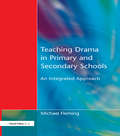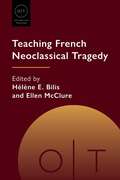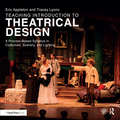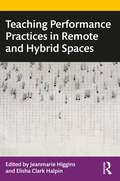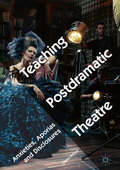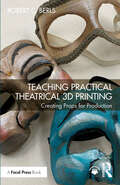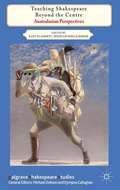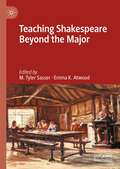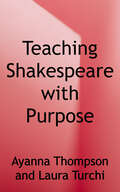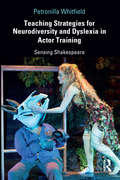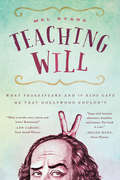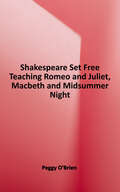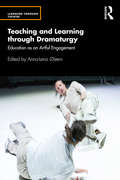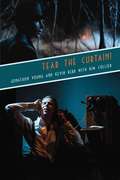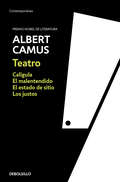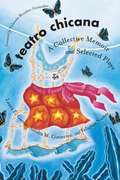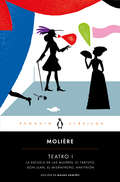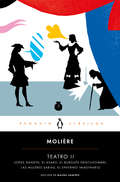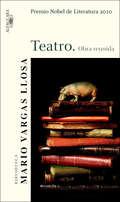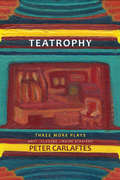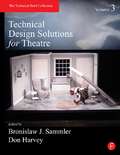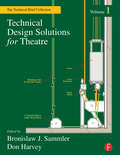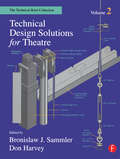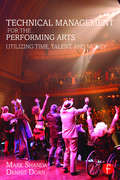- Table View
- List View
Teaching Drama in Primary and Secondary Schools: An Integrated Approach
by Michael FlemingThis book will be of major interest to student teachers, teachers, lecturers and researchers. It provides a case for an integrated approach to the teaching of drama in primary and secondary schools that will help practitioners develop a theoretical rationale for their work. It also offers practical examples of lesson plans and schemes of work designed to give pupils a broad and balanced experience of drama. These are presented within a framework that argues for an integration of content and form, means and ends, and internal and external experience.Whereas the author's previous work argued for an inclusive approach that reconciled polarized views about performance drama and improvisation, this book shows how those activities can be related to each other in practice in an integrated curriculum.
Teaching French Neoclassical Tragedy (Options for Teaching #55)
by Hélène E. Bilis and Ellen McClureTragedy has been reborn many times since antiquity. Seventeenth-century French playwrights composed tragedies marked by neoclassical aesthetics and the divine-right absolutism of the Grand Siècle. But their works also speak to the modern imagination, inspiring reactions from Barthes, Derrida, and Foucault; adaptations and reworkings by Césaire and Kushner; and new productions by francophone and anglophone directors.This volume addresses both the history of French neoclassical tragedy--its audiences, performance practice, and development as a genre--and the ideas these works raise, such as necessity, free will, desire, power, and moral behavior in the face of limited choices. Essays demonstrate ways to teach the plays through a variety of lenses, such as performance, spectatorship, aesthetics, rhetoric, and affect. The book also explores postcolonial engagement, by writers and directors both in and outside France, with these works.
Teaching Introduction to Theatrical Design: A Process Based Syllabus in Costumes, Scenery, and Lighting
by Eric Appleton Tracey LyonsTeaching Introduction to Theatrical Design is a week-by-week guide that helps instructors who are new to teaching design, teaching outside of their fields of expertise, or looking for better ways to integrate and encourage non-designers in the design classroom. This book provides a syllabus to teach foundational theatrical design by illustrating process and application of the principals of design in costumes, sets, lights, and sound.
Teaching Performance Practices in Remote and Hybrid Spaces
by Jeanmarie HigginsThis collection of insightful essays gives teachers’ perspectives on the role of space and presence in teaching performance. It explores how the demand for remote teaching can be met while at the same time successfully educating and working compassionately in this most ‘live’ of disciplines. Teaching Performance Practices in Remote and Hybrid Spaces reframes prevailing ideas about pedagogy in dance, theatre, and somatics and applies them to teaching in face-to-face, hybrid, and remote situations. Case studies from instructors and professors provide essential, practical suggestions for remotely teaching a vast range of studio courses, including tap dance, theatre design, movement, script analysis, and acting, rendering this book an invaluable resource. The challenges that teachers are facing in the early twenty-first century are addressed throughout, helping readers to navigate these unprecedented circumstances whilst delivering lessons, guiding workshops, rehearsing, or even staging performances. This book is invaluable for dance and theatre teachers or leaders who work in the performing arts and related disciplines. It is also ideal for any professionals who need research-based solutions for teaching performance online.
Teaching Postdramatic Theatre: Anxieties, Aporias and Disclosures
by Glenn D’CruzThis book explores the concept and vocabulary of postdramatic theatre from a pedagogical perspective. It identifies some of the major anxieties and paradoxes generated by teaching postdramatic theatre through practice, with reference to the aesthetic, cultural and institutional pressures that shape teaching practices. It also presents a series of case studies that identify the pedagogical fault lines that expose the power-relations inherent in teaching (with a focus on the higher education sector as opposed to actor training institutions). It uses auto-ethnography, performance analysis and critical theory to assist university teachers involved in directing theatre productions to deepen their understanding of the concept of postdramatic theatre.
Teaching Practical Theatrical 3D Printing: Creating Props for Production
by Robert C. BerlsTeaching Practical Theatrical 3D Printing: Creating Props for Production is a cohesive and practical guide for instructors teaching 3D printing techniques in stagecraft, costume and props courses.Written for the instructor, this book uses non-technical language to explain 3D printers, their workflows and products. Coverage includes the ins and outs of multiple filaments, pros and cons of different types of printers, shop or laboratory setup and safety concerns. The book features lesson plans, rubrics and class-tested sample student projects from design to finished product that highlight learning objectives and methodologies, as well as software and hardware usage explanations and common problems that can occur within design and printing. Step-by-step instructions are included for many types of projects, including fake noses, candlestick phones, buttons, 3D scans, historical recreations and linear actuators. The book also contains examples of poor, average and excellent work with grading explanations and guidance on how to help the student move to the next level with their projects. Chapter objectives, chapter summaries, checklists and reflection points facilitate an instructor in gaining confidence with 3D printers and incorporating their use in the classroom.Teaching Practical Theatrical 3D Printing is an excellent resource for instructors of Props and Costume Design and Construction courses that are interested in using state of the art tools and technology for theatre production.Fully editable files for every object featured in the book are available at www.routledge.com/9781032453279, allowing readers to jump-start their projects and giving them the flexibility to change and redesign the items to best fit their needs.
Teaching Shakespeare Beyond the Centre
by Penny Gay Kate Flaherty L. E. SemlerShowcasing a wide array of recent, innovative and original research into Shakespeare and learning in Australasia and beyond, this volume argues the value of the 'local' and provides transferable and adaptable models of educational theory and practice.
Teaching Shakespeare Beyond the Major
by M. Tyler Sasser Emma K. AtwoodThis edited collection considers the task of teaching Shakespeare in general education college courses, a task which is often considered obligatory, perfunctory, and ancillary to a professor’s primary goals of research and upper-level teaching. The contributors apply a variety of pedagogical strategies for teaching general education students who are often freshmen or sophomores, non-majors, and/or non-traditional students. Offering instructors practical classroom approaches to Shakespeare’s language, performance, and critical theory, the essays in this collection explicitly address the unique pedagogical situations of today’s general education college classroom.
Teaching Shakespeare With Purpose: A Student-centred Approach
by Ayanna Thompson Laura TurchiWhat does it mean to teach Shakespeare with purpose? It means freeing teachers from the notion that teaching Shakespeare means teaching everything, or teaching "Western Civilisation" and universal themes. Instead, this invigorating new book equips teachers to enable student-centred discovery of these complex texts. Because Shakespeare's plays are excellent vehicles for many topics --history, socio-cultural norms and mores, vocabulary, rhetoric, literary tropes and terminology, performance history, performance strategies -- it is tempting to teach his plays as though they are good for teaching everything. <p><p>This lens-free approach, however, often centres the classroom on the teacher as the expert and renders Shakespeare's plays as fixed, determined, and dead. Teaching Shakespeare with Purpose shows teachers how to approach Shakespeare's works as vehicles for collaborative exploration, to develop intentional frames for discovery, and to release the texts from over-determined interpretations. In other words, this book presents how to teach Shakespeare's plays as living, breathing, and evolving texts.
Teaching Strategies for Neurodiversity and Dyslexia in Actor Training: Sensing Shakespeare
by Petronilla WhitfieldTeaching Strategies for Neurodiversity and Dyslexia in Actor Training addresses some of the challenges met by acting students with dyslexia and highlights the abilities demonstrated by individuals with specific learning differences in actor training. The book offers six tested teaching strategies, created from practical and theoretical research investigations with dyslexic acting students, using the methodologies of case study and action research. Utilizing Shakespeare’s text as a laboratory of practice and drawing directly from the voices and practical work of the dyslexic students themselves, the book explores: the stress caused by dyslexia and how the teacher might ameliorate it through changes in their practice the theories and discourse surrounding the label of dyslexia the visual, kinaesthetic, and multisensory processing preferences demonstrated by some acting students assessed as dyslexic acting approaches for engaging with Shakespeare’s language, enabling those with dyslexia to develop their authentic voice and abilities a grounding of the words and the meaning of the text through embodied cognition, spatial awareness, and epistemic tools Stanislavski’s method of units and actions and how it can benefit and obstruct the student with dyslexia when working on Shakespeare Interpretive Mnemonics as a memory support and hermeneutic process, and the use of color and drawing towards an autonomy in live performance This book is a valuable resource for voice and actor training, professional performance, and for those who are curious about emancipatory methods that support difference through humanistic teaching philosophies.
Teaching Will: What Shakespeare and 10 Kids Gave Me that Hollywood Couldn't
by Mel RyaneWhat happens when an idealist volunteers to introduce Shakespeare to a group of unruly kids? Bedlam. Tears. And hard lessons learned. Convinced that children can relate to Shakespeare's themes--power, revenge, love--Mel Ryane launches The Shakespeare Club at a public school. Teaching Will is a riotous cautionary tale of high hopes and goodwill crashing into the realities of classroom chaos. Every week Mel encounters unexpected comedy and drama as she and the children struggle toward staging a production of A Midsummer Night's Dream. Woven through this fish-out-of-water tale is Mel's own story of her childhood aspirations, her acting identity, and the heartbreaking end of her onstage career. In the schoolyard, Mel finds herself embroiled in jealousy and betrayal worthy of Shakespeare's plots. Fits of laughter alternate with wiping noses as she and the kids discover a surprising truth: they need each other if they want to face an audience and triumph. Teaching Will is an uplifting story of empowerment for dreamers and realists alike.
Teaching a Midsummer Night's Dream, Romeo and Juliet, and Macbeth: Shakespeare Set Free (Folger Shakespeare Library)
by Peggy O'BrienThe Folger Shakespeare Library, the nation's most important center for Shakespeare study and scholarship, is also the center for Shakespeare education. At the Library's Teaching Shakespeare Institute, scholars, actors, and teachers from across the country work together in the business of teaching and learning Shakespeare. This volume of the Shakespeare Set Free series is written by institute faculty and participants and includes the latest developments in recent scholarship. It bristles with the energy created by teaching and learning Shakespeare from the text and through active performance and reflects the experience, wisdom, and wit of real classroom teachers in schools and colleges throughout the United States. In this book, you will find the following:-Clearly written essays by leading scholars to refresh teachers and challenge older students -Michael Tolaydo’s brilliant and accessible technique for classroom teaching through performance -Day-by-day teaching strategies that successfully and energetically immerse students in every grade and skill level in the language and the plays themselves – created, taught, and written by real teachers.
Teaching and Learning through Dramaturgy: Education as an Artful Engagement (Learning Through Theatre)
by Anna-Lena ØsternThe aim of this book is to contribute a dramaturgical perspective to education. The authors write from a dramaturgical perspective about the planning of teaching, leadership in the classroom, the teacher-body, the teacher’s oral skills and ethics, communication, and about the spaces in which teaching takes place. The book is written with the pre-understanding that the ways in which art creates knowledge need to be illuminated and articulated more clearly in educational thinking, thereby enhancing artful engagement in education. Dramaturgical perspectives are presented as such a way – a form of knowledge that the artform of drama/theatre can contribute to teaching and learning in general. Through examples and analyses of empirical material, as well as through theoretical perspectives, the authors show chapter by chapter how dramaturgy and a dramaturgically inspired language and concepts create more possibilities of choice for teachers in planning and carrying out their teaching. Teaching and Learning through Dramaturgy brings to the forefront what will be enabled in teaching and planning of teaching, by making use of a dramaturgically inspired language and action, what in principle is possible in every subject.
Tear the Curtain!
by Jonathon Young Kim Collier Kevin KerrIn this psychological thriller set in a fictionalized 1930s Vancouver, Alex Braithwaite, a troubled but passionate theatre critic, believes he has found the legendary Stanley Lee, director of the infamous avant-garde theatre "The Empty Space." Alex becomes convinced that this man's radically subversive ideas are what the artistic community of the city needs to shatter audience complacency. In his pursuit of the truth behind Stanley Lee's mysterious disappearance and his artistic ideas, Alex becomes caught between the warring factions of two prominent mob families - one controlling the city's playhouses, the other its cinemas, but both ensnared by the Empty Space Society. At the dawn of the Talkies, can Alex tear through the artifice of these art forms in time to save the city's art community from ripping itself apart?The play's collaborators found inspiration within the walls of Vancouver's Stanley Theatre, a space that has a dual history as a cinema and vaudeville house. Fittingly, this gritty film-noir production became an exploration of the two kinds of art and how they affect the audience. Tear the Curtain! explores global issues that consider what we want from art: to be shocked and surprised or for order to be restored.Cast of 2 women and 8 men.
Teatro
by Albert CamusLa cuatro grandes obras de teatro originales de Albert Camus reunidas en un solo volumen, con un prólogo inédito del autor El presente volumen reúne las cuatro obras de teatro originales de Albert Camus: El malentendido (1944), Calígula (1945), El estado de sitio (1948) y Los justos (1949). Todas pertenecen a lo que podría llamarse el teatro moral o de ideas, relacionado formal y temáticamente con la tragedia clásica, a la que el autor era muy afecto. Sus temas y ambientes abarcan desde el sino trágico de una familia en plena Segunda Guerra Mundial hasta los ataques terroristas de un grupo de revolucionarios rusos, pasando por un brote de peste en una Cádiz imaginaria, o una recreación histórica de los excesos del tirano romano Calígula. Pero Camus sabía que al reflejar momentos históricos todo artista acaba hablando del presente. Así pues, en estas obras escritas a caballo de la Segunda Guerra Mundial encontramos sus preocupaciones habituales sobre el absurdo, la rebeldía, la sociedad y el individuo modernos. El autor ha dicho:«¿Por qué hago teatro? Pues bien, a menudo me lo he preguntado. Y la única respuesta que he podido dar hasta ahora parecerá de una trivilidad descorazonadora: simplemente porque el escenario de un teatro es uno de los lugares del mundo donde soy feliz. El teatro me ofrece la comunidad que necesito [...] Aquí todos estamos vinculados los unos a los otros sin que nadie deje de ser libre o casi: ¿no es una buena fórmula para la sociedad futura?»
Teatro Chicana
by Laura E. Garcia Sandra M. Gutierrez Felicitas NuñezThe 1970s and 1980s saw the awakening of social awareness and political activism in Mexican-American communities. In San Diego, a group of Chicana women participated in a political theatre group whose plays addressed social, gender, and political issues of the working class and the Chicano Movement. In this collective memoir, seventeen women who were a part of Teatro de las Chicanas (later known as Teatro Laboral and Teatro Raíces) come together to share why they joined the theatre and how it transformed their lives. Teatro Chicana tells the story of this troupe through chapters featuring the history and present-day story of each of the main actors and writers, as well as excerpts from the group's materials and seven of their original short scripts.
Teatro I: La escuela de las mujeres / El tartufo / Don Juan / El misántropo / Anfitrión
by MolièreUno de los mayores dramaturgos europeos en una edición magistral a cargo de Mauro Armiño. El presente volumen, primero de dos dedicados al teatro de Molière, reúne cinco de sus grandes comedias, estrenadas entre 1662 y 1668, cuando su compañía conquistó los escenarios de París. En La escuela de las mujeres tuvo su primer gran éxito; con El Tartufo desató el escándalo; en Don Juan enriqueció un nuevo mito europeo; con El misántropo ofreció un agudo análisis de la necedad; y en Anfitrión parodió los entresijos de la corte. En conjunto, estas piezas geniales no solo exponen las flaquezas humanas, sino que castigan con el ridículo a quienes más a salvo se creen de ellas. Nuestra edición, a cargo de Mauro Armiño, uno de los mejores traductores y críticos literarios de la actualidad, se completa con una espléndida introducción, notas explicativas y noticias sobre el contexto histórico-literario de las comedias.
Teatro II: Georges Dandin / El avaro / El burgués gentilhombre / Las mujeres sabias / El enfermo imaginario
by MolièreSegundo tomo de las obras esenciales de Molière, uno de los mayores dramaturgos de la literatura europea, a cargo de Mauro Armiño El presente volumen, con el que completamos nuestra selección del teatro de Molière, reúne cinco de sus grandes comedias, estrenadas entre 1668 y 1673, durante el último lustro de vida del autor. Jorge Dandín castiga los sueños de ascenso social; El avaro ataca la codicia de la burguesía en el siglo xvii; El burgués gentilhombre satiriza los códigos huecos de la aristocracia; Las mujeres sabias pone el punto de mira en la pedantería; y El enfermo imaginario ironiza sobre los límites subjetivos de la salud. En estas piezas tardías, el inigualable comediógrafo amplía su registro hasta alcanzar por momentos el sentimiento trágico de la vida. Nuestra edición, a cargo de Mauro Armiño, uno de los grandes traductores y críticos literarios de la actualidad, se completa con notas explicativas y cuidadas noticias sobre el contexto histórico-literario de las comedias.
Teatro. Obra reunida
by Mario Vargas LlosaLa obra dramatúrgica reunida en un volumen del premio Nobel Mario Vargas Llosa. «El teatro y su imaginería son un género privilegiado para representar el inquietante laberinto de ángeles, demonios y maravillas que es la morada de nuestros deseos.»Mario Vargas Llosa La creación teatral de Mario Vargas Llosa, desconocida para muchos de quienes ya han disfrutado de su narrativa, es parte imprescindible de su carrera y sus inquietudes literarias. Este género le permite ahondar en una de las constantes de su obra: la medida en que las historias que relatamos y nos relatamos, las fantasías con las que pretendemos abrillantar cada día, son una manera de ensanchar nuestra existencia más allá de los límites que impone la realidad cotidiana. La señorita de Tacna (1981), Kathie y el hipopótamo (1983), La Chunga (1986), El loco de los balcones (1993) y Ojos bonitos,cuadros feos (1996), cinco textos dramáticos donde temas tan cardinales para el ser humano como la familia, la vejez, el orgullo, el destino, el amor, los deseos, el machismo, la dinámica entre presente y pasado y la naturaleza del talento creador quedan envueltos por otro: el papel de la ficción en la vida, la rectificación de la vida que obra la ficción.
Teatrophy
by Peter CarlaftesIn Teatrophy: Three More Plays, critically-acclaimed playwright/author/poet Peter Carlaftes offers a trio of brilliant and intense modern plays that inspire on both page and stage. In "Anti,” Carlaftes explores a frightening future-in which government surveillance and data mining is the norm-through the eyes of a theater director on the verge of giving up hope. The chilling psycho-sexual drama "Closure” examines the relationship between a woman whose sister was abused a child, and the rapist-murderer that stalks her outside her therapist’s office. In the tender and humorous "Inside Straight,” characters must confront their lovers’ sudden shift in sexual orientation as a gay man and a lesbian woman discover they are attracted to each other. The San Francisco Bay Guardian praised the play: "Inside Straight is a comedy of eros! . . . A restive heart knows no logic or permanence. ” All three plays share a passion for beautifully drawn, full characters and powerful moments that force them to expose the true identity they work so hard to hide. As the SF Weekly raved, "As with Strindberg, Beckett or even Sartre, Carlaftes’ message seems to be something we intuit, like music. ”
Technical Design Solutions for Theatre Volume 3: The Technical Brief Collection Volume 1
by Bronislaw J Sammler Don HarveyTechnical Design Solutions for Theatre is a collection of single-focus articles detailing technical production solutions that have appeared in The Technical Brief Collection, a publication of the Yale School of Drama’s Technical Design and Production Department. The primary objective of the publication was to share creative solutions to technical problems so that fellow theatre technicians can avoid having to reinvent the wheel with each new challenge. The range of topics includes scenery, props, painting, projections, sound, and costumes. Each article describes an approach, device, or technique that has been tested onstage or in a shop. Great reference of tips and solutions to persistent technical challenges in theatre production Solutions provided by contributors from over twenty different producing organizations Ten years of The Technical Brief Collection articles bound in each of three volumes A comprehensive index to all three volumes included in Volume III
Technical Design Solutions for Theatre: The Technical Brief Collection Volume 1
by Don Harvey Bronislaw J. SammlerThe Technical Brief is a collection of single-focus articles on technical production solutions, published three times a year by the prestigious Yale School of Drama. The primary objective of the publication is to share creative solutions to technical problems so that fellow theatre technicians can avoid having to reinvent the wheel with each new challenge. The range of topics includes scenery, props, painting, electrics, sound, and costumes. The articles each describe an approach, device, or technique that has been tested on stage or in a shop by students and professionals. Some articles included: Growing Flowers on Stage; Break-Away Glass; Photo-Murals for the Stage; Quiet Wire-Rope Curtain Track; Free Standing Curved Stairs; A Measured Approach to Kerfing; A Low-Voltage Remote Controller for Special Effects; Toggle-Clamp Locks; Comparing Four Plastics as Scenery Glides; Low Pressure Air Casters; A Simple Lift Jack; Using a Piano to Create a Reverberation Effect; Horn-Hat Mics for Sound Reinforcement
Technical Design Solutions for Theatre: The Technical Brief Collection Volume 2
by Don Harvey Bronislaw J. SammlerThe Technical Brief is a collection of single-focus articles on technical production solutions, published three times a year by the prestigious Yale School of Drama. The primary objective of the publication is to share creative solutions to technical problems so that fellow theatre technicians can avoid having to reinvent the wheel with each new challenge. The range of topics includes scenery, props, painting, electrics, sound and costumes. The articles each describe an approach, device, or technique that has been tested on stage or in a shop by students and professionals. Some articles included are: Building Authentic Elizabethan Ruffs; Simple and Inexpensive Stained Glass; A Quick-Load Floor Pulley Design; A Simple Approach to Stretching Drops; Flexi-Pitch Escape Stairs; Spot-Welding Scrim with Sobo; Handrail Armatures for a Grand Staircase; The Triscuit-Studwall Deck System; A Frameless Turntable; Stand on Stage: Minimum Weight, Maximum Effect; A Self-Paging Cable Tray; Roller Chain Turntable Drives; A Bench-Built XLR Cable Tester
Technical Design Solutions for Theatre: The Technical Brief Collection Volume 2
by Bronislaw J. SammlerThe Technical Brief is a collection of single-focus articles on technical production solutions, published three times a year by the prestigious Yale School of Drama. The primary objective of the publication is to share creative solutions to technical problems so that fellow theatre technicians can avoid having to reinvent the wheel with each new challenge. The range of topics includes scenery, props, painting, electrics, sound and costumes. The articles each describe an approach, device, or technique that has been tested on stage or in a shop by students and professionals. Some articles included are: Building Authentic Elizabethan Ruffs; Simple and Inexpensive Stained Glass; A Quick-Load Floor Pulley Design; A Simple Approach to Stretching Drops; Flexi-Pitch Escape Stairs; Spot-Welding Scrim with Sobo; Handrail Armatures for a Grand Staircase; The Triscuit-Studwall Deck System; A Frameless Turntable; Stand on Stage: Minimum Weight, Maximum Effect; A Self-Paging Cable Tray; Roller Chain Turntable Drives; A Bench-Built XLR Cable Tester
Technical Management for the Performing Arts: Utilizing Time, Talent, and Money
by Mark Shanda Dennis DornTechnical Management for the Performing Arts: Utilizing Time, Talent, and Money is a comprehensive guide to the tools and strategies of a successful technical manager. This book demonstrates how you can coordinate personnel, raw materials, and venues, all while keeping a production on a tight schedule and within budget. From concept to realization, through nightly performances, Technical Management for the Performing Arts focuses on the technical and organization skills a technical manager must demonstrate, and emphasizes the need for creativity and interpersonal management of a team.
